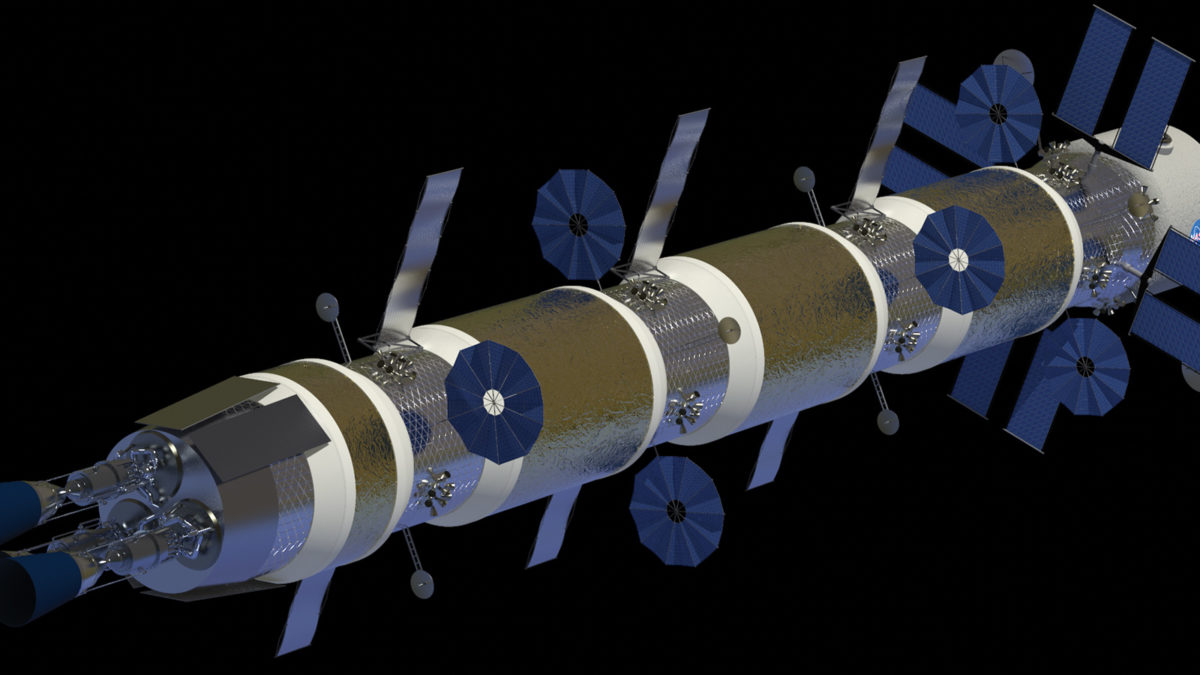Nuclear propulsion planning focuses on modular, sustainable designs
By BRYAN PALASZEWSKI|December 2019
The Nuclear and Future Flight Propulsion Technical Committee works to advance the implementation and design of nonchemical, high-energy propulsion systems other than electric thruster systems.
Since 2016, NASA has been exploring low-enriched uranium, LEU, reactors for nuclear thermal propulsion or NTP. The LEU NTP project, led by NASA, is aimed at developing a demonstrator to fly before 2030 as a test for crewed missions to Mars. Significant conceptional design evaluations and work were completed toward LEU NTP in 2019.
In February, the LEU NTP project received additional funding and initiated several studies with industry and U.S. Energy Department labs.
In May, Aerojet Rocketdyne refined its predicted performance modeling of an LEU NTP engine.
In July, researchers at NASA’s Marshall Space Flight Center in Alabama revisited demonstrator vehicle concepts through various design cycles.
In August, retired nuclear engineer David Black published a study concluding that low-enriched uranium reactors, though higher in mass than a highly enriched uranium reactor, can be designed to meet the mission, lifetime and operability requirements of NTP missions while simultaneously offering less stringent safety, security and proliferation concerns.
Also in August, the Energy Department’s Sandia National Laboratories, Oak Ridge National Laboratory and Idaho National Laboratory worked with Marshall and BWX Technologies of Virginia to develop a path forward for LEU NTP fuel selection and reactor design.
In other advanced propulsion areas, NASA’s Innovative Advanced Concepts office in April conducted a Phase II midterm review for a proposal awarded in 2018 to California State University-Fullerton to continue its experimental efforts examining the Mach effect, a theoretical form of gravitational propulsion that does not expel mass and only uses electrical power. CSU-Fullerton has been developing and testing Mach effect devices for 25 years as well as refining the theory of operation. Experiments in Germany, Canada and Italy and by multiple independent researchers in the U.S. are heavily focused on thrust balance calibration, experimental procedure, signal amplification and corrections to the theory. The forces generated from these devices are generally less than 10 micronewtons, but the true nature and source of the signals remains inconclusive. If the theory is found to be legitimate, Mach effect research could pave the way for new propulsion physics and have applications well beyond space systems.
Researchers from Quantum Fields LLC in Illinois; the Institute for Advanced Studies in Texas; and the Center for Astrophysics, Space Physics and Engineering Research at Baylor University in Texas published new results in August on producing and accessing the negative quantum vacuum energy densities theoretically required by general relativity to produce novel propulsion schemes such as warp drives and worm holes. This work noted the startling fact that the theoretical quantum inequality restrictions needed to generate such energies have not been experimentally tested. The researchers analyzed the various technical schemes known to produce “squeezed vacuum states” with the technique called a “squeezed light” and discovered that the restrictions were violated in the evaluated published quantum optics squeezed light experiments (represented by 25 years of published data). The Casimir effect (with negative vacuum energy density in the space between the two Casimir cavity walls) is also expected to demonstrate experimental violation of quantum inequality, but this experiment has yet to be demonstrated in the lab because of numerous technical challenges. The consequence of the experimental violations of quantum inequality was that nature does not impose any truly significant constraint on technologically producing and accessing negative vacuum energy density; this result implied that there should be no roadblock to artificially producing a warp drive or a traversable wormhole to achieve faster-than-light propulsion for interstellar flight.
In August, Stan Borowski presented a summary of recent design studies in both nuclear thermal propulsion and in-situ resource utilization that could lead to viable experiments blending the two technologies. This work will be critical for planning and modeling missions using NTP. Borowski retired in December 2018 from NASA’s Glenn Research Center after a 30-year career.
Contributors: Eric Davis and Greg Meholic



































